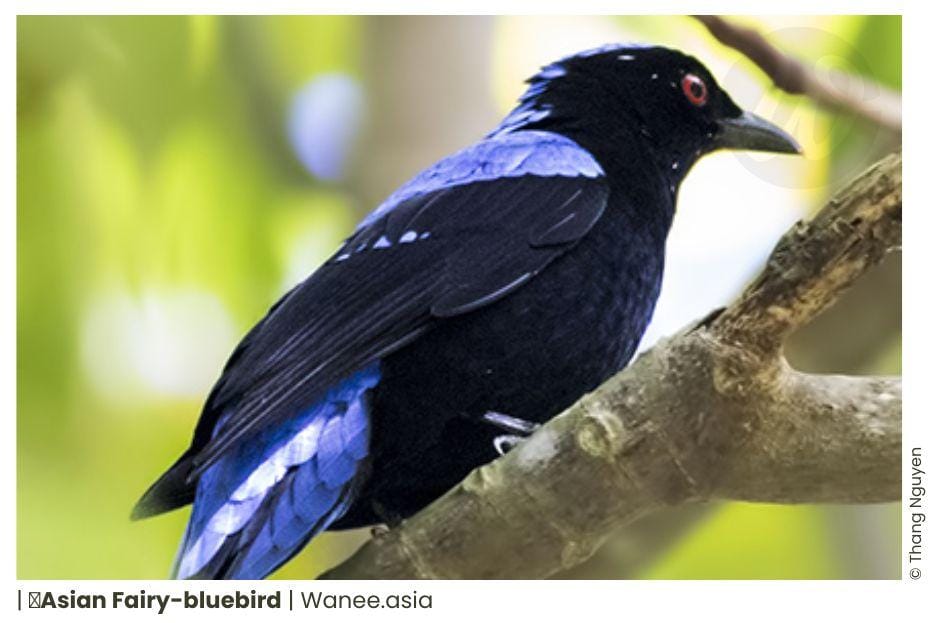Asian Fairy-Bluebird in Vietnam – Irenidae
The Asian Fairy-Bluebird is a beautiful bird species found in the forests of Vietnam. Here are seven stunning facts about this colorful jewel:
- Appearance: The male have a bright blue plumage, while females have a duller blue-green color with a grayish belly. They have a distinctive long and curved beak, and their eyes are surrounded by a vivid blue ring.
- Habitat: They prefers to live in the dense forests and woodlands of Vietnam. They are most commonly found at an altitude between 500-1,500 meters above sea level.
- Distribution: They are widely distributed in Asia, and their range extends from the Indian subcontinent to Southeast Asia.
- Behavior:They are active and agile birds and are often found foraging for insects and fruit in the treetops. They are known for their acrobatic flights and can often be seen performing aerial maneuvers in pursuit of prey or during courtship displays.
- The Asian Fairy-bluebird family is known for its beautiful and melodious song. The male bird produces a series of flute-like notes that are both sweet and clear. Their song is often described as a series of clear, ringing notes that ascend in pitch before ending in a final trill. The female also sings, but her song is less elaborate and shorter than the male’s. These birds are often heard singing in the early morning or during the breeding season. Their beautiful songs add to the enchanting beauty of these colorful birds in the forests of Vietnam.
- Diet: They feeds on a variety of insects and fruits, including berries, figs, and insects.
- Reproduction: Asian Fairy-Bluebirds form monogamous pairs during the breeding season, which usually occurs between January and May. The female will lay two to three eggs in a cup-shaped nest constructed from twigs and grass.
- Conservation status: The Asian Fairy-Bluebird is classified as a species of Least Concern by the IUCN Red List, but habitat loss due to deforestation is a significant threat to their populations. Conservation efforts are focused on protecting their forest habitats and promoting sustainable forest management practices

Where to spot Asian Fairy-Bluebird in Vietnam?
You can often spot this bird in pairs or small groups, eating fruits and insects high up in the trees. If you’re birdwatching for Asian Fairy-Bluebird in Vietnam, look for its bright blue feathers and red eyes, and listen for its sweet, musical calls. Here are 6 Vietnam biodiversity hotspots for you to spot them in their natural habitat:
- Cat Tien National Park – A prime location with dense lowland forests, where it’s often seen foraging in the canopy.
- Bach Ma National Park – Known for its rich birdlife, including the Fairy-bluebird in its misty highland forests.
- Phong Nha-Ke Bang National Park – Offers excellent chances to see them in mixed forest habitats.
- Ba Be National Park – A lesser-visited site but still a good place to look in mature forests.
- Central Highlands (Kon Tum, Da Lat Plateau) – Sometimes spotted in the remaining old-growth forests.
- Con Dao National Park – Occasionally reported on the island, though not as common as on the mainland.
All Vietnam Birds Families
Wildlife Tours for Asian Fairy-Bluebird in Vietnam
At WANEE, we believe that the more we appreciate nature, the more we’ll want to protect it. That’s why our tours are designed to inspire a deeper love for wildlife and a stronger commitment to conservation. While trying harder every day to protect the balance of nature, our wildlife tours give tourists the chance to explore Vietnam’s natural beauty, understand how different habitats connect, and take action to protect them.
Scheduled Wildlife Tours
Tailored Wildlife Tours
Click here to see more tailored tour options
Visit our sites:
– Facebook: WANEE Vietnam (Wild and Nature Exploring)
– Instagram: WANEE Vietnam and WANEE Kids hub
Are you looking for Wildlife Tours in Vietnam?
WANEE VIETNAM is your go-to destination for "Wildlife Tours in Vietnam", specializing in Birding, Primate Watching, Herping, Photography Tours and Educational Tours led by our expert guides.Hot-spot for Birding in Vietnam
all birding in hot-spot informative info [updated Jan 2023]
Nr. Nature reserve; Np. National Park; mt. Mountain
Crocodile Trail – The Best Birding Trail in Cat Tien National Park
If you’re a birder or nature photographer planning a trip to Vietnam, few places offer [...]
Cong Troi Trail – Top 1 Dalat Plateau Birding Trail Experience
If you’re a birder or nature photographer planning a trip to Vietnam’s Central Highlands, the [...]
How to Identify the Greater Sand Plover, Tibetan Sand Plover and Siberian Sand Plover
Identification Differences within the Sand Plover Complex: The sand plover group, which was traditionally divided [...]
Highlights of Cat Tien National Park Reptiles and Amphibian Endemics
Spanning over 71,350 hectares of tropical forests, grasslands, and wetlands, Cat Tien National Park is [...]
Highlights of Cat Tien National Park Mammals in a World Biosphere Reserve
In addition to reptiles and birds, Cat Tien National Park is also rich in mammals, [...]
Kontum Plateau Endemic and Highlight bird
Kontum Plateau Endemic And Highlight Bird species like Chestnut-eared Laughingthrush and top birding routes while [...]